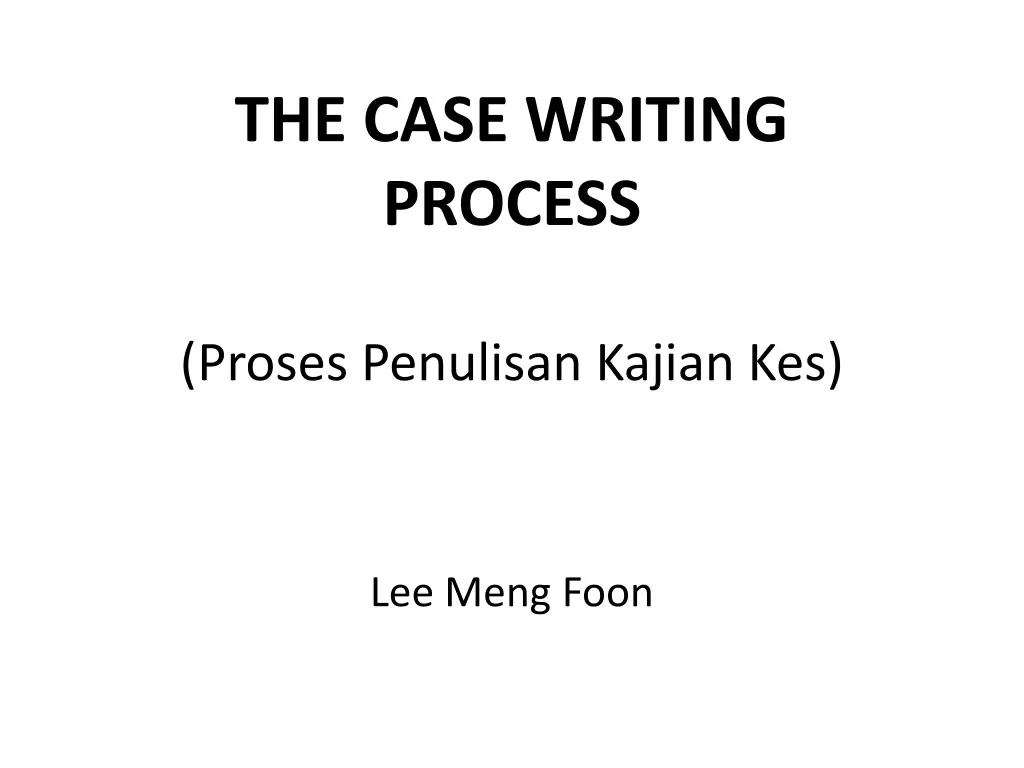
Effective Case Writing Process for Research Studies
Discover the comprehensive process of case writing for research studies, including planning, drafting, and revision. Explore the essential steps such as problem identification, diagnosis, proof of causes, and action planning. Enhance your skills with practical exposure and field research insights.
Download Presentation

Please find below an Image/Link to download the presentation.
The content on the website is provided AS IS for your information and personal use only. It may not be sold, licensed, or shared on other websites without obtaining consent from the author. If you encounter any issues during the download, it is possible that the publisher has removed the file from their server.
You are allowed to download the files provided on this website for personal or commercial use, subject to the condition that they are used lawfully. All files are the property of their respective owners.
The content on the website is provided AS IS for your information and personal use only. It may not be sold, licensed, or shared on other websites without obtaining consent from the author.
E N D
Presentation Transcript
THE CASE WRITING PROCESS (Proses Penulisan Kajian Kes) Lee Meng Foon
Outline of Presentation What is Case Writing? The Case Writing Process Planning the Case Writing : - Problem identification - Diagnosis - Proof of causes - Action plan The Case Format Drafting the Case Case Revision
Case Writing Involves the case writer observing the working of the process under analysis and recording what is happening. Case writer examines the meaning of the observations and interpret them within the context of the prescribed or theoretical framework. Requires practical exposure to hone case writing skills.
Case Writing In field research, case writer needs to make field trips to the chosen entity/organization. Cooperation is required from the entity/organization to gather information. Case writer needs to gather data, organize and discard some data, then write the case. Entity/organization needs to give permission to the case writer to publish the research for the purposes of teaching and learning.
Case Writing Process Case writing provides the opportunity for reflection and creative efforts. The case writing process involves: Planning Drafting the case Revision
Planning A case on a problem situation has four parts: 1. Problem identification 2. Diagnosis 3. Proof of causes 4. Action plan
Problem Identification The problem identification should express the effects or outcomes identifiable in the situation that the entity or main character in the case should be most concerned about. The opening paragraph defines the problem by describing the key effects or outcomes that constitutes the problem.
Diagnosis After the problem has been defined, summarize the diagnosis or the principal causes of the problem. Common sense and intuition are helpful but are not sufficient. Causal analysis will require theoretical concepts and frameworks appropriate to the situation.
Proof of Causes/Diagnosis List the primary causes of the problem and provide evidence for each cause. List action plan ideas for each cause. The general purpose of a problem action plan is to improve the current situation by acting on the causes of the problem. Cause Evidence Action Plan Ideas
Action Plan State the goal(s) of the action plan : the major outcome(s) that the action plan steps are supposed to bring about. List the action plan steps for the short term and the long term. Identify the major risks and responses that can undermine the action plan. Propose responses that will eliminate or contain such risks.
Planning Case writing requires focus, structure and dramatics (feelings/emotions) Case writer needs to ask several questions: - what kind of solution is required? - what would be the outcome expected? - what is the performance to be evaluated? These questions enable the case writer to define the objectives of the case study
The Case Format Introduction (Prologue/Opening Paragraph) - date & place; critical incident/relevant issues - name and identity of the entity & main character(s) Body - history/background of the entity/organization - details relating to the environment and situation - description of the problem(s) and causes of the problem(s) - Conclusion (Epilogue/Closing Paragraph) - the point when immediate action is needed to solve the problem.
Drafting the Case Provides adequate information to help the case user to understand and determine the issues and problem(s) as it has been presented Develops a strong desire for the case user to solve the problem (sense of urgency) The content is in line with the questions raised The actual situation and the main characters may not be identified (need for disguise?) The case is supported by additional notes (industry notes, technical notes etc.) to help in analyzing the case.
Revision Cases that have been drafted need to be revised several times Revising involves re-reading, evaluating and making changes to improve the case After the first draft, keep the case aside for a while for the writer to think about other aspects of the case (cooling period) Review appropriateness of the language for the target group/case users; factors that create the sense of reality for the case user; length of the case; and the sequence that supports the flow of the case.






















